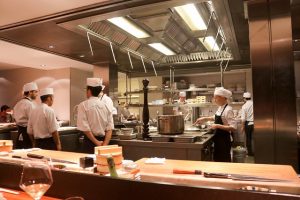
 The secret to minimizing the cost of your restaurant kitchen lies in your maintaining the kitchen design and layout. An efficient workspace will ensure the time taken to have food plated and set on the dining tables is less, whilst also eliminate needless equipment costs.
First sketch an outlay or block diagram of your kitchen, and plan where you’re going to put up all the larger chunks of equipment. For instance, your coolers and ice makers should be kept at bay from your oven, range or grill. If you try to place them close to a heat source, you need to ensure they’re cool on the interior, escalating energy costs and taking a heavy toll on them.
Try to separate food prep tasks into their own site or station using their own tools. You can save a lot of precious time on monitoring equipment use and searching specialized kitchen tools.
Plating and final prep should be placed as close to the door as possible leading to the dining room. Otherwise making your way into the hustle and bustle of the kitchen can turn out daunting and stressful. After all the sound of the broken plates scattered all over the ground is the last thing you may want to hear!
Health and safety regulations permitting, you can centralize the entire ventilation system to keep down costs. Dishwashing areas should be isolated from food prep areas.
Should you let steam out of dishwasher, it can obscure visibility and spoil delicate foods.
Give way to natural lighting by positioning stations below windows or skylights. This can bring your energy costs down.
The kitchen space should undergo constant improvements and upgrades. Your staff could tell you what works and what doesn’t in terms of fine adjustments made to the kitchen.
Lastly, maintain a complete inventory of things in your kitchen. There should be one personnel per station as one point person assisting the maintenance of equipment inventory. He or she should be entrusted in reporting a lost or missing item, and find a replacement immediately.
The above mentioned steps should help kitchen owners understand where they could control costs and stay more competitive in business.
The secret to minimizing the cost of your restaurant kitchen lies in your maintaining the kitchen design and layout. An efficient workspace will ensure the time taken to have food plated and set on the dining tables is less, whilst also eliminate needless equipment costs.
First sketch an outlay or block diagram of your kitchen, and plan where you’re going to put up all the larger chunks of equipment. For instance, your coolers and ice makers should be kept at bay from your oven, range or grill. If you try to place them close to a heat source, you need to ensure they’re cool on the interior, escalating energy costs and taking a heavy toll on them.
Try to separate food prep tasks into their own site or station using their own tools. You can save a lot of precious time on monitoring equipment use and searching specialized kitchen tools.
Plating and final prep should be placed as close to the door as possible leading to the dining room. Otherwise making your way into the hustle and bustle of the kitchen can turn out daunting and stressful. After all the sound of the broken plates scattered all over the ground is the last thing you may want to hear!
Health and safety regulations permitting, you can centralize the entire ventilation system to keep down costs. Dishwashing areas should be isolated from food prep areas.
Should you let steam out of dishwasher, it can obscure visibility and spoil delicate foods.
Give way to natural lighting by positioning stations below windows or skylights. This can bring your energy costs down.
The kitchen space should undergo constant improvements and upgrades. Your staff could tell you what works and what doesn’t in terms of fine adjustments made to the kitchen.
Lastly, maintain a complete inventory of things in your kitchen. There should be one personnel per station as one point person assisting the maintenance of equipment inventory. He or she should be entrusted in reporting a lost or missing item, and find a replacement immediately.
The above mentioned steps should help kitchen owners understand where they could control costs and stay more competitive in business.
Copyright © 2025 EssEmm Corporation